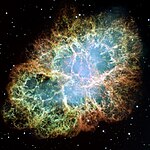Portal:Astronomy/Featured/November 2006

The Crab Nebula (catalogue designations M1, NGC 1952) is a supernova remnant in the constellation of Taurus. The nebula was first observed in 1731 by John Bevis. It is the remnant of a supernova that was recorded by Chinese and Arab astronomers in 1054. Located at a distance of about 6,300 light years (1.93 kpc) from Earth, the nebula has a diameter of 11 ly (1.84 pc) and is expanding at a rate of about 1,500 kilometres per second.
The Crab Nebula contains a pulsar in its centre which rotates twenty eight times per second, emitting pulses of radiation from gamma rays to radio waves. The nebula was the first astronomical object identified with a historical supernova explosion.
The nebula acts as a source of radiation for studying celestial bodies that occult it. In the 1950s and 1960s, the Sun's corona was mapped from observations of the Crab's radio waves passing through it, and more recently, the thickness of the atmosphere of Saturn's moon Titan was measured as it blocked out X-rays from the nebula.
Recently featured: Mercury – Fermi Paradox – Definition of planet
| ...Archive | Read more... |
